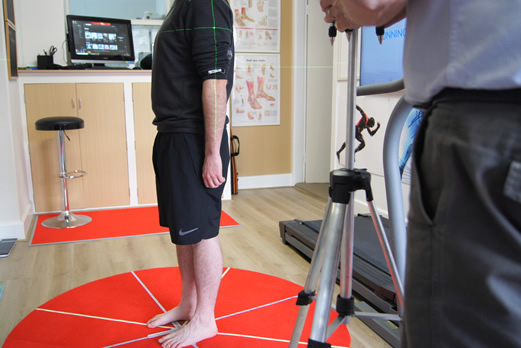Musculoskeletal Assessment
A musculoskeletal Biomechanical assessment is the process of analysing the functions of the lower limbs. It is performed by your qualified AMA Podiatrist to determine the reason for impaired foot function and identify how the body compensates for these irregularities.
The goals of Biomechanical assessment are to understand the causes and mechanisms of your condition and present ways to correct the issues arising from any alignment issue.
How is the assessment performed?
Your Biomechanical assessment is generally a 30-45 min appointment and is performed in our biomechanics laboratory where your podiatrist can conduct a range of specific tests. Patients are asked to wear a pair of shorts, so movement of lower limbs are visible and easily recorded. Biomechanical assessments are divided into two key areas, static and dynamic:
Exam

Pathology
We check medical and family history and exam imaging including x-rays, ultrasound and MRI. Functional testing and preliminary examination to understand the cause of any lower limb or foot abnormalities.
Static

Range of Motion
Joint range of motion testing involves non weight bearing anatomical examination which focuses on muscle testing, and no-weight bearing lower limb posture assessment. Hips knee’s and ankles and limb length discrepancy.
Dynamic

Static Weight Bearing
During your static weight bearing test, we review the static testing already conducted and how the body relates (under loading) considering the placement of shoulders, hips and foot position.

Balance and coordination
We inspect your balance and coordination through a range of specific testing. S.E.B.T (star excursion balance test), balance board and single leg squats. These test looks at hips and knee strength.

Walking & Video Gait Assessment
During your walking and video gait analysis we check your body’s movement through hip knee ankle and foot function. Through muscle strength and activation, proprioreceptive testing, balance and neurological gait assessment. Either through walking or running.
The results of the Biomechanical assessment will take into consideration several factors, including age, range of motion, occupation or sports engaged in, postural alignment and genetic predisposition. AMA Podiatry will then prescribe a treatment plan which may include a referral to other practitioners, orthotic therapy or strength and conditioning training.
We consider all treatment therapies to ensure an accurate treatment plan before any Orthotic recommendations are considered.
Orthotic Therapy
Conditions Orthotic Therapy assist
Orthotic therapy is used for the treatment and prevention of common lower limb function conditions such as:

- Plantar Fasciitis/Heel Pain
- Sever’s Disease (growth plate)
- Heel Pain/Severs Disease
- Knee Pain/Osgood Schlatter’s Syndrome
- Achilles Tendonitis
- Shin/Splints post tibial dysfunction
- Lower back Pain & Hip pain
- Hamstrings
- Post tibial Dysfunction
- Bunions-Hammer Toes
Do I need Orthotics?
An orthotic is a corrective device that can either support, align and correct the function of the body’s musculoskeletal system.
When we have severe Bio Mechanical problems it can impact on your feet, knee’s, hips and lower back. Our custom made Orthotic is designed to support and align the function of your feet, control planes of motion and alleviate a range of musculoskeletal issues not limited to the feet.
Our custom made Orthotic, with all 3 planes of motion which has been corrected, enables your AMA Podiatrist to alter certain movements and or offload stress within the tissues of the foot.
Correctly aligned Orthotics are very effective in offering support and control, where we not only stabilize the foot, we stabilize the entire Skeletal System.
More Information or Make a Booking
For more information on how we can help you, please call us on 9576 9495 or complete our enquiry form: Enquiry Form
